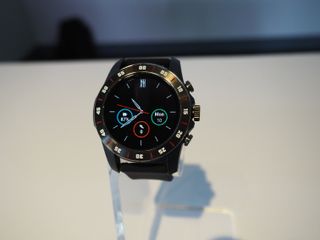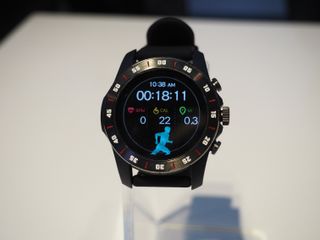I Got A Sneak Peek at the Future of Wear OS
Qualcomm just showed off a reference design with all of the features that will make Wear OS watches worth buying.
I’ve tried out dozens of Wear OS watches in the last few years. dating back to when the operating system for smartwatches was still known as Android Wear. I appreciate their style, which ranges from simple and utilitarian to bold and flashy, and the fact that Wear OS devices come in a variety of sizes for petite wrists and larger ones. I even like the Wear OS interface, which is about to get even better with a software overhaul.

But Wear OS had a big problem: 80 percent of devices on the platform use Qualcomm’s Snapdragon 2100 chip, which is two-and-a-half years old — and, more critically, showing its age.
Qualcomm announced today (Sept. 10) that its new smartwatch CPU, the Snapdragon Wear 3100, is ready to roll with a handful of partners preparing to launch devices with the next-gen chip this year. Qualcomm didn’t have any production watches from those partners on hand at the 3100 announcement in San Francisco, but the company showed a glimpse of the features the new chip will enable on a reference design watch on display at the event.
MORE: 5 Ways Snapdragon Wear 3100 Is Fixing Wear OS Watches
I got a sneak peek at those features demoed on the reference watches, and if the 3100 lives up to its promise, the competition between Apple’s watchOS and Google’s Wear OS platforms just got a lot more more interesting.
Useful, Stylish, Long-Lasting
Qualcomm’s goal for Snapdragon Wear 3100 is to help you get the most out of your Wear OS watch without sacrificing style or functionality. Qualcomm spent the last two-and-a-half years working on new technology that offloads minor smartwatch tasks from the main processor to a tiny co-processor, allowing the watch to run smoothly without draining the battery.
Sign up to get the BEST of Tom’s Guide direct to your inbox.
Upgrade your life with a daily dose of the biggest tech news, lifestyle hacks and our curated analysis. Be the first to know about cutting-edge gadgets and the hottest deals.
It’s tough to tell how effective that is without using a watch running on the 3100 chip for a few days, but an early demo of three new features enabled by the next-gen chip was enough to catch my attention.
Ambient Mode vs. Interactive Mode

Unlike the Apple Watch, which goes dark when you’re not looking at it, Wear OS watches running on Wear 3100 will have a full-color, always-on display that can display real-time complications. Watches will be able to seamlessly switch between interactive mode, when your attention is on the watch, and ambient mode, when the always-on display is activated. The reference model had a visible shift between the two so I could tell when ambient mode was on, but the two modes look identical and there will be no such shift in smartwatches that ship to buyers.
A new traditional watch mode will also help eke out more days of use on a charge. When I saw it demonstrated on a reference smartwatch, I was impressed. You can still see a full-color display when you lift your wrist to check the time, instead of a sad monochromatic one that lets the world know you haven’t charged your watch. Unlike ambient mode, traditional watch mode turns the display off when it’s not in use to help the device last up to a week on a charge.
Next Year: A focus on fitness
A new sports mode wasn’t quite as exciting as I had hoped; the reference watch demo simply showed what a workout in ambient mode would look like. The always-on display will show your heart rate, mileage, time elapsed and calories burned in real-time, even though the co-processor is doing all the heavy lifting. That’s more of a technical feat than one that users will notice when they work out, though. It will help a Wear OS watch last 15 hours with GPS and heart rate activated, though, which people will definitely notice.

Sports mode will be more sophisticated than the other features enabled by Wear 3100, Qualcomm wearables chief Pankaj Kedia told me, which is why it’s launching with an as-yet-unnamed sports watchmaker early next year instead of rolling out with watches from Montblanc, Fossil and Louis Vuitton this year.
Coming soon
The first devices to run on Wear 3100 are Montblanc’s Summit 2, due out in October, and new watches from Fossil Group and Louis Vuitton. Those watches are all fashion-focused, so we won’t see the sports mode in action until 2019.
Google isn’t releasing its own smartwatch this year because there isn’t yet a one-size-fits-all solution, Wear OS Director of Engineering Miles Barr confirmed to me at last month's IFA trade show. Qualcomm’s Pankaj Kedia reiterated that idea during an interview at the 3100 announcement on Monday, telling me that the Montblanc smartwatch buyer and the sports smartwatch buyer are two different people.
But I’m not convinced that’s true. I want a smartwatch that can transition from my morning run to the office to a formal event without sacrificing style, battery life or performance. I raised that issue with Kedia.
"You would not wear the same pair of shoes all of those places," Kedia said. "Fashion is very personal. Our job is to bring the platform with a lot of flexibility, and different customers innovate."
Will Snapdragon Wear 3100 be the foundation for a versatile, one-size-fits-all Wear OS watch? I hope so.
Image Credits: Tom's Guide
Caitlin is a Senior editor for Gizmodo. She has also worked on Tom's Guide, Macworld, PCWorld and the Las Vegas Review-Journal. When she's not testing out the latest devices, you can find her running around the streets of Los Angeles, putting in morning miles or searching for the best tacos.
